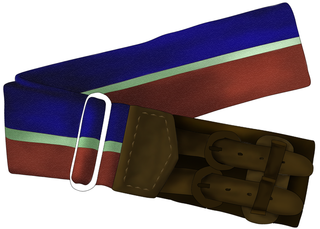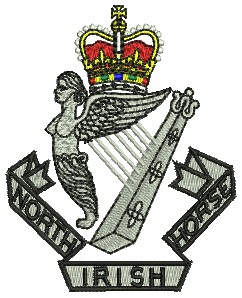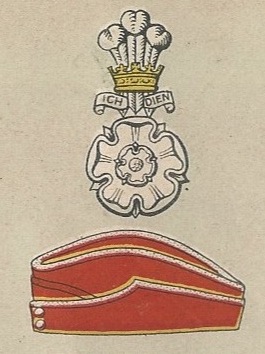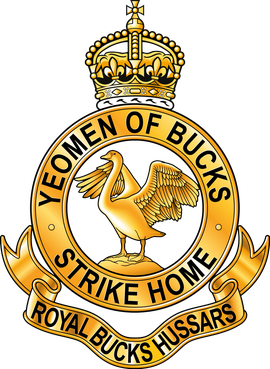Precedence is the order in which the various corps of the British Army parade, from right to left, with the unit at the extreme right being highest.
The British Army has frequently been the subject of amalgamation and re-organisation throughout its history. The general rule for establishing the order of precedence is the date of creation of the regiment and its subsequent unbroken service. [1] Disbanded regiments automatically lost precedence. Since 1994 two orders of precedence used parochially and unofficially within the Yeomanry; the Army List of 1914 and the Order of Yeomanry Titles on parade at The Royal Yeomanry Review. Irrespective of this, official precedence within the Army is set out in King's Regulations.
The first is a list of yeomanry units on the establishment at the outbreak of the First World War and therefore contains units that had been disbanded by the time of The Royal Yeomanry Review. This first list does not contain the North Irish, South Irish or King Edward's Horse who were on the Special Reserve at this time. The First Aid Nursing Yeomanry do not appear as they are not part of the British Army or its reserve.
The second order of precedence represents units that were on the establishment of the Territorial Army at the time of the review. Order of precedence in this instance includes the current role of the unit, placing Armoured Corps before Artillery and so on. Since the review, several units and sub-units have changed role and corps or been disbanded.
The approach taken at The Royal Yeomanry Review can be summarised as follows:
The following is taken from the last page of the programme printed for The Royal Yeomanry Review. As on that day, the list below has been divided into blocks corresponding to the order in which the units formed and grouped.

Yeomanry is a designation used by a number of units and sub-units in the British Army Reserve which are descended from volunteer cavalry regiments that now serve in a variety of different roles.

A stable belt is a striped coloured belt worn at times by the armed forces of the United Kingdom, other Commonwealth countries, and a few other countries including Denmark, Brazil and Lebanon. The stripes vary by regiment and corps, identifying the wearer's unit. In Brazil and Lebanon they are known as gymnastic belts.
Options for Change was a restructuring of the British Armed Forces in summer 1990 after the end of the Cold War.

The Royal Mercian and Lancastrian Yeomanry was a yeomanry regiment of the United Kingdom's Territorial Army. It served in the armoured replacement role, providing replacement tank crews for regular armoured regiments.

The Queen's Own Yeomanry (QOY) is one of the Army Reserve light armoured reconnaissance regiments.
The British Army is listed according to an order of precedence for the purposes of parading. This is the order in which the various corps of the army parade, from right to left, with the unit at the extreme right being highest. Under ordinary circumstances, the Household Cavalry parades at the extreme right of the line. Militia and Army Reserve units take precedence after Regular units with the exception of The Honourable Artillery Company and The Royal Monmouthshire Royal Engineers.

The North Irish Horse was a yeomanry unit of the British Territorial Army raised in the northern counties of Ireland in the aftermath of the Second Boer War. Raised and patronised by the nobility from its inception to the present day, it was one of the first non-regular units to be deployed to France and the Low Countries with the British Expeditionary Force in 1914 during World War I and fought with distinction both as mounted troops and later as a cyclist regiment, achieving eighteen battle honours. The regiment was reduced to a single man in the inter war years and re-raised for World War II, when it achieved its greatest distinctions in the North African and Italian campaigns. Reduced again after the Cold War, the regiment's name still exists in B Squadron, the Scottish and North Irish Yeomanry and 40 Signal Squadron, part of 32 Signal Regiment.

The Essex Yeomanry was a Reserve unit of the British Army that originated in 1797 as local Yeomanry Cavalry Troops in Essex. Reformed after the experience gained in the Second Boer War, it saw active service as cavalry in World War I and as artillery in World War II. Its lineage is maintained by 36 Signal Squadron, part of 71 (Yeomanry) Signal Regiment, Royal Corps of Signals.
The Queen's Own Warwickshire and Worcestershire Yeomanry (QOWWY) was a regiment of the Royal Armoured Corps, forming part of the Territorial Army (TA). Following reductions in 1969 and 1971 respectively the regiment was reduced to two and later one company sized sub-unit in 1999. Following a reorganisation in 2021, there are now two successors to the regiment: one squadron in the Royal Yeomanry as light cavalry, and one squadron in the 37th Signal Regiment as a support squadron.

The Home Service Force (HSF) was a Home Guard type force established in the United Kingdom in 1982. Each HSF unit was placed with either a Regular Army or Territorial Army regiment or battalion for administrative purposes and given that formation's title, cap badge and recruited from volunteers aged 18–60 with previous British forces experience. It was introduced to guard key points and installations likely to be the target of enemy special forces and saboteurs, so releasing other units for mobile defence roles. It was stood down in 1992 due to budget cuts.

The Duke of Lancaster's Own Yeomanry (DLOY) was a yeomanry unit of the British Army from 1798 to 1992. Originally raised as part-time cavalry for home defence and internal security, the regiment sent mounted infantry to serve in the Second Boer War. During World War I it carried out mounted duties in Egypt and Palestine and on the Western Front. By 1917 the reserve units at home had become cyclists and the regiment serving on the Western Front joined an infantry battalion, seeing action at the Battle of Passchendaele, against the German Spring Offensive and in the final Allied Hundred Days Offensive. At the beginning of World War II the regiment gave up its horses and formed two regiments of medium artillery, which served in the Middle East, Italy and North West Europe. Postwar it became an armoured unit. Today its lineage is maintained by B Squadron, the Queen's Own Yeomanry.

The Yorkshire Hussars was an auxiliary unit of the British Army formed in 1794. The regiment was formed as volunteer cavalry (Yeomanry) in 1794 during the French Revolutionary Wars and served in the Second Boer War and the First World War. It was converted to an armoured role during the Second World War. In 1956, it merged with two other Yorkshire yeomanry regiments to form the Queen's Own Yorkshire Yeomanry. Its lineage is continued today by the Queen's Own Yeomanry.

The Queen's Own Yorkshire Dragoons was a yeomanry regiment of the British Army in existence from 1794 to 1956. It was formed as a volunteer cavalry force in 1794 during the French Revolutionary Wars. Its volunteer companies played an active role with the Imperial Yeomanry in the Second Boer War, but opportunities for mounted action were much more restricted during the First World War and it was temporarily converted into a cycle unit. It remained a cavalry regiment throughout the interwar years, and was the last horsed unit of the British Army to see action, in the Syria–Lebanon Campaign of 1941, finally mechanising the following year. It served as motorised infantry in the North African and Italian campaigns of the Second World War. In 1956, it merged with the Yorkshire Hussars and the East Riding of Yorkshire Yeomanry to form the Queen's Own Yorkshire Yeomanry. Its lineage is continued today by A Squadron, the Queen's Own Yeomanry.

The Royal Buckinghamshire Yeomanry is an Operational Hygiene Squadron of the Royal Logistic Corps, originally formed as cavalry in 1794, and has also served in artillery and signals roles. The lineage is continued by 710 Operational Hygiene Squadron, Royal Logistic Corps.
During the First World War the British Armed Forces was enlarged to many times its peacetime strength. This was done mainly by adding new battalions to existing regiments. Although sometimes identified by shoulder titles, generally the new battalions could not be identified from appearance. Consequently, the units in this list have been assembled considering only those as having a uniquely different cap badge.

The British yeomanry during the First World War were part of the British Army reserve Territorial Force. Initially, in 1914, there were fifty-seven regiments and fourteen mounted brigades. Soon after the declaration of war, second and third line regiments were formed. However, the third line regiments were soon absorbed into the Cavalry Reserve Regiments, to supply replacements for the cavalry and yeomanry. Other horsed regiments in the British Army, during the war, were the regular cavalry regiments and the three regiments belonging to the special reserve: the North Irish Horse, the South Irish Horse and the King Edward's Horse. The senior yeomanry regiments could trace their origins back over 100 years; the oldest regiment, the Royal Wiltshire Yeomanry, had been formed in 1794. The most junior regiment, the Welsh Horse, had only been formed on 18 August 1914, after the start of the war.

Yeomanry are part of the reserve for the British Army. At the start of First World War there were fifty-four yeomanry regiments in the British Army. Soon after the declaration of war, it was decided to increase the number of these volunteer mounted regiments. The new regiments were mirror formations of the existing first line regiments, with the same name and served initially in the same brigades. However they were all classed as second line units. The first line regiments, were numbered the 1/1st while the second line became the 2/1st or in cases where there were more regiments with the same name, or already numbered, the 2/2nd or 2/3rd.